A linear scar created after strip surgery makes it difficult to wear a classic short haircut that is closely shaved on the back of the head. This patient from Venice Beach, Los Angeles learned this lesson from his own personal experience. He chose the strip hair transplant method, performed at another clinic, to restore his hair. However, he ended up regretting this decision. With the remaining scars, he couldn’t wear his hair the way he most wanted. His hairline was pluggy and recessed. Also, he faced the problem of transplanted hair not growing in the crown. He decided on a Dr.UGraft™ FUE (Follicular Unit Extraction) surgery for a hair transplant scar cover-up. In this procedure, he also wanted to address other objectives such as the crown and hairline. Because of the reliable growth enabled by Dr.UGraft™ procedures and Dr. Umar’s aesthetic skills, he was confident about realizing the outcome he envisioned.
Before Photos of Venice Beach Patient- Visible Strip Scar and Transplanted Hair Not Growing
Here are images of the patient before his Dr.UGraft™ surgery for a hair transplant scar cover-up and overall repair. These photos depict the issues he wanted to correct, which included a receded, pluggy hairline and temples, noticeable strip scars and no growth in the crown (vertex).
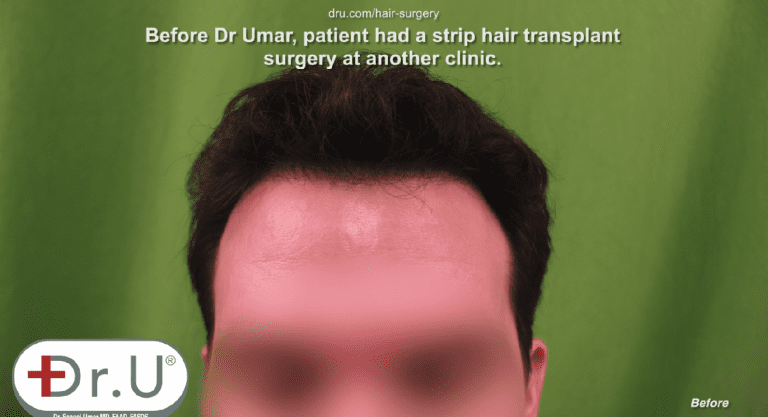
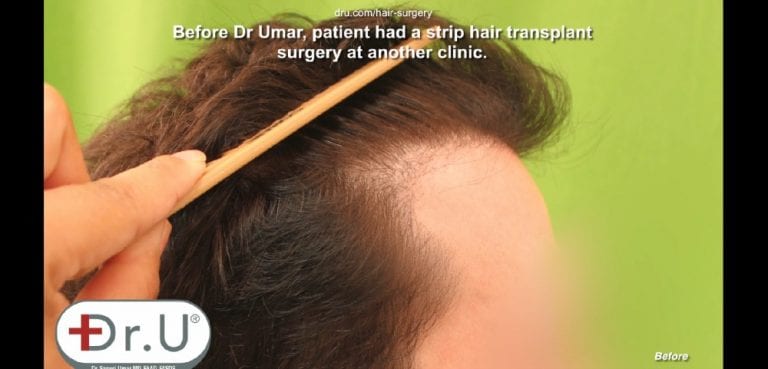
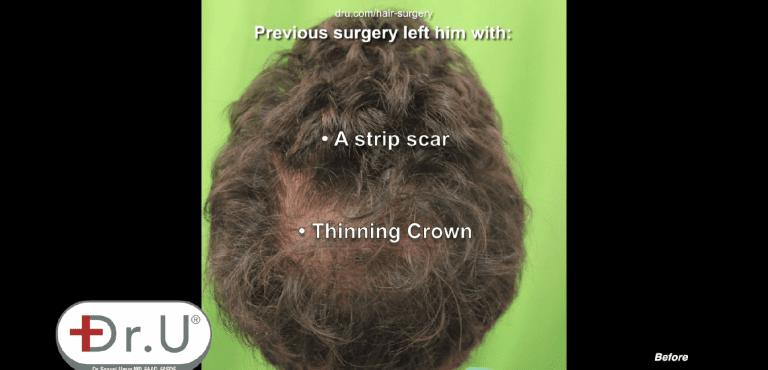
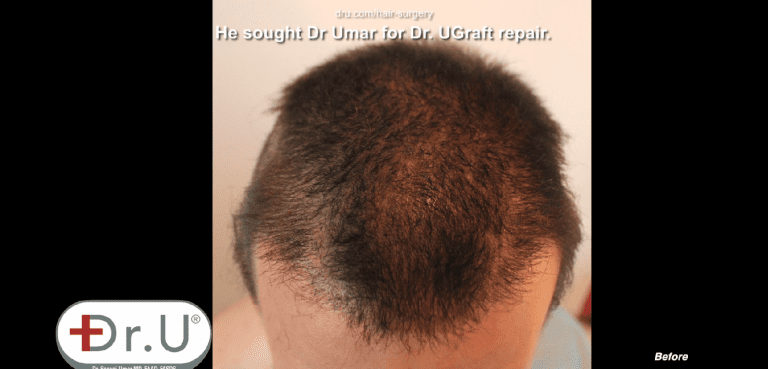
Dr.UGraft™ Procedure Photos – Hair Transplant Scar Cover-Up and Patient’s Repair Objectives
This patient had enough donor hair left on his scalp to meet the goals of his procedure. These included:
- coverage of the strip scarring
- restoring the thinning crown
- revising the hairline
How Dr.UGraft™ Surgeries Produce Better Hairlines with Nape Hair
Dr. Umar harvested 2950 grafts from the head and nape. Nape hair is ideal for the hairline because it is thin. This caliber is much like the fine hairs that grow on the very outer edge of the temples and hairline. Using nape hair grafts makes it possible to create more natural and undetectable looking FUE hairline restoration outcomes.
Harvesting nape follicles require more specialized FUE punch tools. Compared to regular head hair, nape hair grows at much sharper angles. In conventional FUE procedures, the provider relies on this visual cue to determine how to align their punch. However, regular cylinder shaped punches are more likely to injure the graft when they attempt to follow these extremely acute angles.
Problematic Extraction with Basic Punch – Example
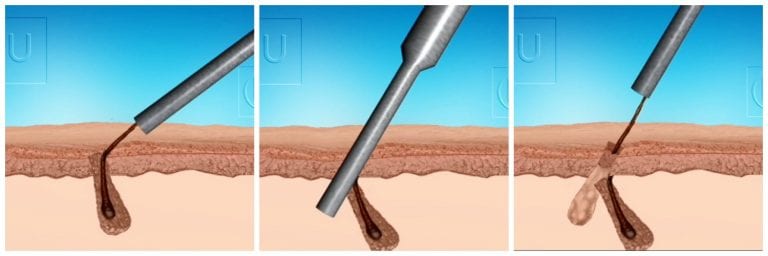
With Dr.UGraft™ rotary punches, there is no need to precisely align the device with the hair angle. This self-navigating technology has a patented mechanism which grips the tissue surrounding the follicle(s) and pulls it upward as the cutting edge scores around the graft. Hair angles become a non-issue with these devices. Dr.UGraft™ rotary punches are built with features that can safely extract body and head hair in large quantities without relying exclusively on human precision which naturally fluctuates.
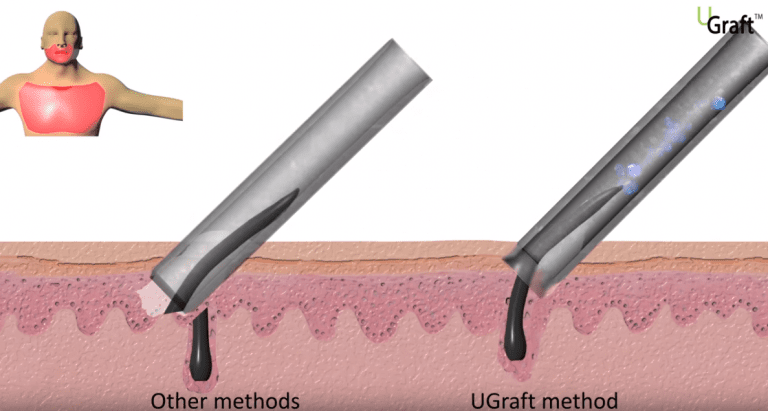
The Dr.UGraft™ Advantage for Reliable Growth Yield
This patient wanted to avoid the predicament of failed growth which he experienced from his strip procedure. He chose Dr.UGraft™ surgery for his hair transplant scar cover-up because the technology used is intelligently designed to prevent the most common forms of damage to grafts. This includes;
- air exposure, the top cause of graft failure
- various forms of mechanical injuries (e.g. punch misalignments, graft torsion)
With engineering that avoids these issues, patients can more confidently expect the growth they had planned for.
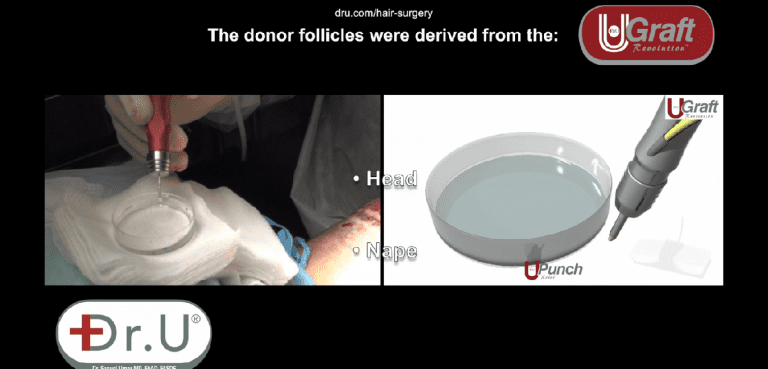
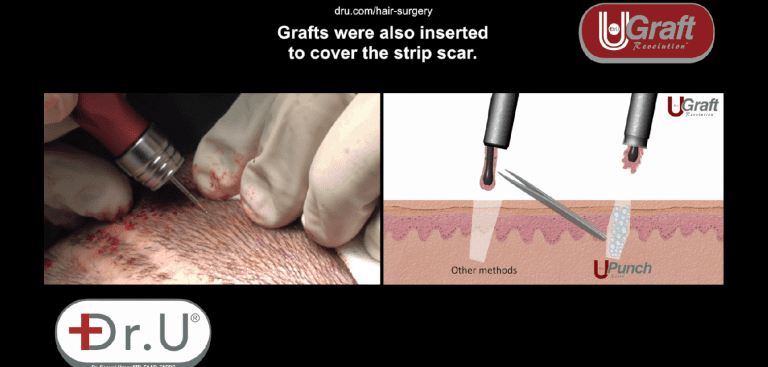
Dr.UGraft™ Hairline, Vertex Hair Transplant Results, and Strip Scar Repair Before and After Photos
Here are before and after photos which show major improvements in the patient’s overall appearance. The images of his outcome were taken by the patient himself, 16 months after his Dr.UGraft™procedure.
Dr.Umar was able to undo hair transplant mistakes in the hairline to create more natural looking growth patterns. Also, he was able to render a more flattering framework around the patient’s face.
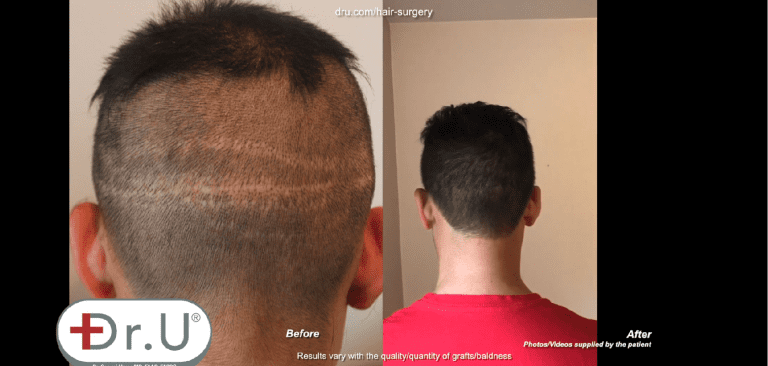
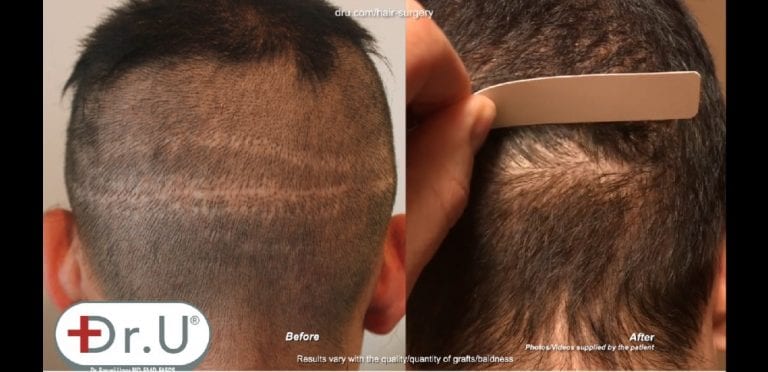
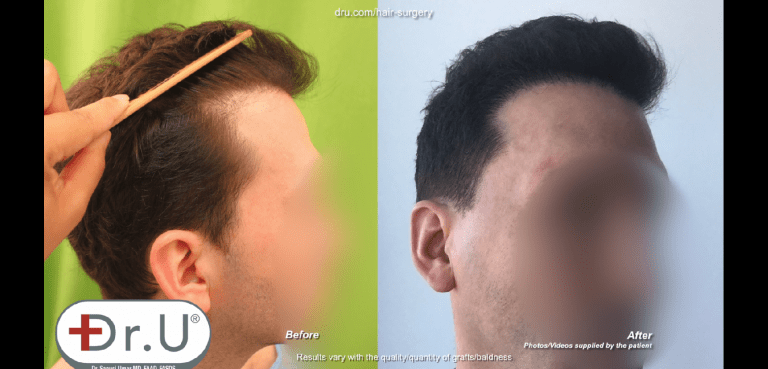
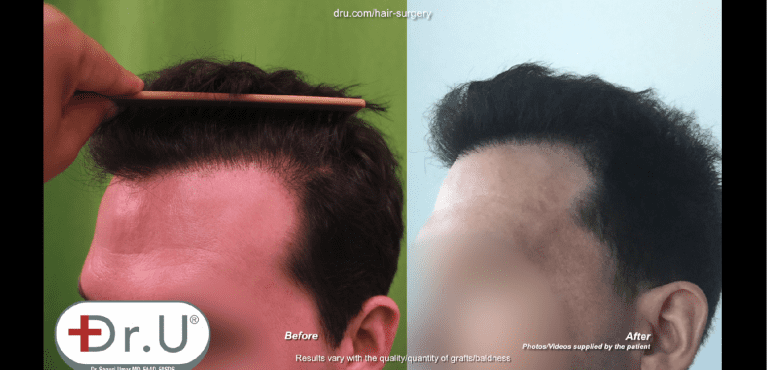
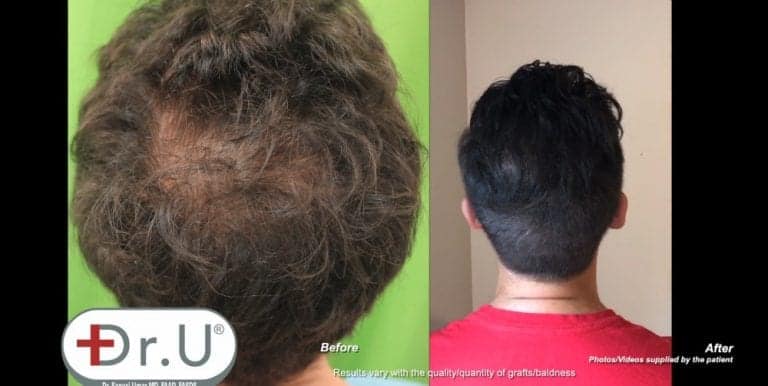
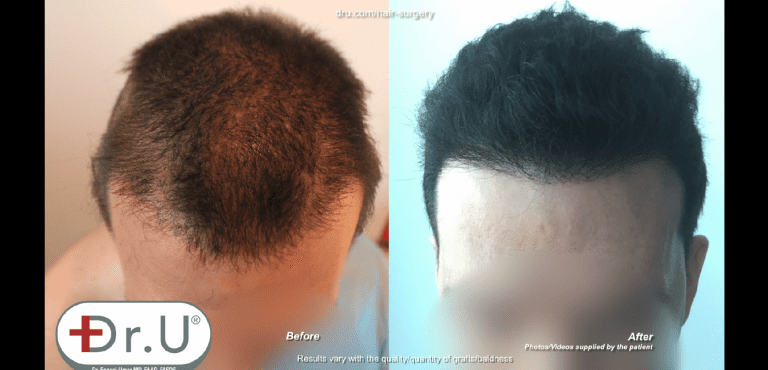
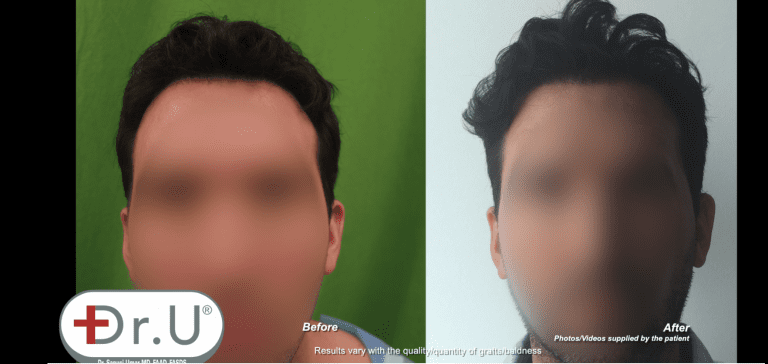
Video: Dr.U Solves the Problem of Linear Scarring and Transplanted Hair Not Growing
Watch this video to learn more about the patient’s hair transplant experience.
To speak to Dr. Umar about repairing bad results from previous surgeries, sign up for a complimentary consultation.
[dt_button link=”/hair-surgery/free-consultation/” target_blank=”false” button_alignment=”center” animation=”fadeIn” size=”big” style=”default” bg_color_style=”default” bg_hover_color_style=”default” text_color_style=”default” text_hover_color_style=”default” icon=”fa fa-chevron-circle-right” icon_align=”left”]FREE CONSULTATION[/dt_button]FAQ – Dr.UGraft™ Hair Transplant Scar Cover-Up
Why doesn’t a strip scar show after a Dr.UGraft™ FUE hair transplant repair?
The hair transplant grafts are inserted into the scar tissue itself to blend in with the surrounding areas. Dr.Umar makes sure to apply the same density and the quality of hair (i.e. when body and head hair is used) to create a seamless appearance between the strip scar area and the rest of the scalp.
What happens if the patient does not have enough grafts left to repair their strip scar and the regions of poor growth?
If additional grafts are needed, it is possible to utilize Dr.UGraft™ rotary punches to harvest body hair from regions like the beard areas of the face and neck, abdomen and torso. These extra resources can expand the donor supply by thousands of grafts to meet the patient’s repair objectives.
The Dr.UGraft™ rotary devices are built with special features to accommodate the extremely sharp angles of body hair. Previous generations of basic FUE punches don’t have this capability and incur a high risk of cutting straight through the graft. The Dr.UGraft™ instruments offer a reliable system for extracting large quantities of body hair follicles, rather than depending entirely on human precision.
Why do many strip surgery supporters claim that this method produces better quality grafts, if patients still suffer from poor growth?
Once the strip has been removed, technicians use microscopes where they can see how to cut around the region surrounding the hair follicle. Proponents of the method argue that with Follicular Unit Extraction, using tiny punches below the skin’s surface may sever the sides of the follicle unit, producing damaged grafts.
However, the view that strip surgery produces better growth than Follicular Unit Extraction is not true. There are many examples where patients do not receive the growth they wanted, like gentleman featured in this case. In general, grafts can be damaged by air exposure and the use of harsh metal tools like forceps. These factors are certainly relevant in strip surgery procedures.
If you have more questions about covering up a hair transplant scar, ask Dr. U:
[dt_button link=”/hair-surgery/ask-dr-umar/” target_blank=”false” button_alignment=”center” animation=”fadeIn” size=”big” style=”default” bg_color_style=”default” bg_hover_color_style=”default” text_color_style=”default” text_hover_color_style=”default” icon=”fa fa-chevron-circle-right” icon_align=”left”]ASK DR. U[/dt_button]
Further Reading
Meet another patient who underwent a Dr.UGraft™ revision for past procedure
Learn about one of Dr. U’s patients who chose a Dr.UGraft™ FUE surgery to correct a failed hairline


